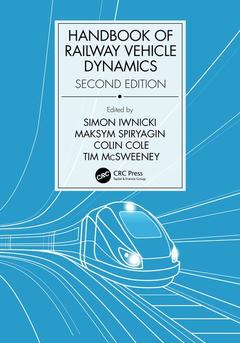Handbook of Railway Vehicle Dynamics, Second Edition (2nd Ed.)
Coordonnateurs : Iwnicki Simon, Spiryagin Maksym, Cole Colin, McSweeney Tim

Handbook of Railway Vehicle Dynamics, Second Edition, provides expanded, fully updated coverage of railway vehicle dynamics. With chapters by international experts, this work surveys the main areas of rolling stock and locomotive dynamics. Through mathematical analysis and numerous practical examples, it builds a deep understanding of the wheel-rail interface, suspension and suspension component design, simulation and testing of electrical and mechanical systems, and interaction with the surrounding infrastructure, and noise and vibration. Topics added in the Second Edition include magnetic levitation, rail vehicle aerodynamics, and advances in traction and braking for full trains and individual vehicles.
1. Introduction 2. A History of Railway Vehicle Dynamics 3. Design of Unpowered Railway Vehicles 4. Design of Powered Rail Vehicles and Locomotives 5. Magnetic Levitation Vehicles 6. Suspension Elements and Their Characteristics 7. Wheel-Rail Contact Mechanics 8. Tribology of the Wheel-Rail Contact 9. Track Design, Dynamics and Modelling 10. Gauging Issues 11. Railway Vehicle Derailment and Prevention 12. Rail Vehicle Aerodynamics 13. Longitudinal Train Dynamics and Vehicle Stability in Train Operations 14. Noise and Vibration from Railway Vehicles 15. Active Suspensions 16. Dynamics of the Pantograph-Catenary System 17. Simulation of Railway Vehicle Dynamics 18. Field Testing and Instrumentation of Railway Vehicles 19. Roller Rigs 20. Scale Testing Theory and Approaches 21. Railway Vehicle Dynamics Glossary
Simon Iwnicki is professor of railway engineering at the University of Huddersfield in the UK, where he is director of the Institute of Railway Research (IRR). The IRR has an international reputation for its research and support to industry, providing not only valuable practical solutions to specific problems in the industry but also making significant contributions to the understanding of some of the fundamental mechanisms of the wheel-rail interaction on which the safe and economical operation of railways depends. Professor Iwnicki is the editor-in-chief of Part F of the Proceedings of the Institution of Mechanical Engineers (the Journal of Rail and Rapid Transit) and co-editor (responsible for railway matters) of the journal Vehicle System Dynamics. He was the academic co-chair of the Rail Research UK Association (RRUKA) from 2010 to 2014, and, from 2014 to 2015, he was chair of the railway division of the Institution of Mechanical Engineers. He is a former member of the Scientific Committee of Shift2Rail.
Maksym Spiryagin is a professor of engineering and the deputy director of the Centre for Railway Engineering at Central Queensland University, Australia. He received his PhD in the field of railway transport in 2004 at the East Ukrainian National University. Professor Spiryagin’s involvement in academia and railway industry projects includes research experience in Australia, China, Italy, South Korea and Ukraine, involving locomotive design and traction, rail vehicle dynamics, acoustics and real-time and software-enabled control systems, mechatronics and the development of complex mechatronic systems using various approaches (co-simulation, software-in-the-loop, processor-in-the-loop and hardware-in-the loop simulations).
Colin Cole is a professor of mechanical engineering and the director of the Centre for Railway Engineering at Central Queensland University, Australia. His work history includes over 31 years in r
Date de parution : 11-2019
17.8x25.4 cm
Thèmes de Handbook of Railway Vehicle Dynamics, Second Edition :
Mots-clés :
Railway Vehicle Dynamics; Vehicle dynamics; Friction Draft Gears; noise control of passing trains; Bogie Frame; railway dynamics; Wheel Rail Contact; magnetic levitation; Roller Rig; vehicle aerodynamics; Railway Vehicle; traction; Railway Track Structure; Braking; Wheel Rail Friction Coefficient; heavy haul train dynamics; Draft Gear; derailment prevention; Vertical Wheel Rail Force; aerodynamics; Wheel Slide Protection Systems; wheel-rail interface; Secondary Suspension; damage; Heavy Haul Locomotives; dynamics; Pantograph Catenary Interaction; flow; Rail Vehicle; friction; Suspension Deflection; locomotive dynamics; Creep Force; mechanics; Track Irregularities; noise; Scaled Roller Rigs; noise control; Longitudinal Train Dynamics; rolling stock; FST; simulation; Tilting Trains; stability; Air Springs; suspension; Track Geometry; testing; Critical Speed; vibration



